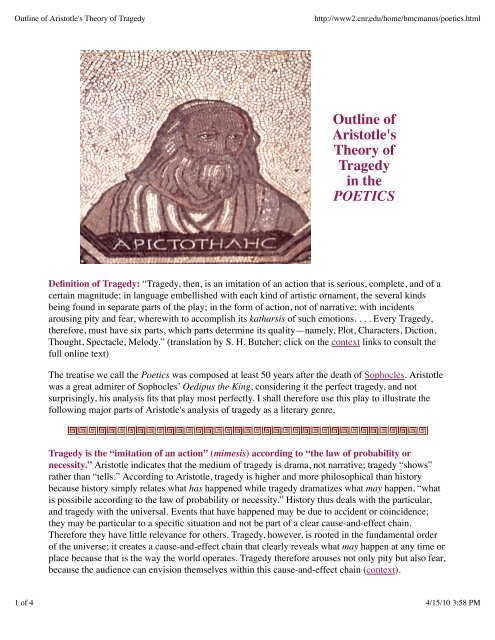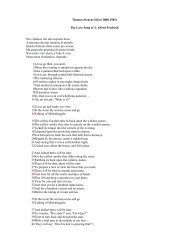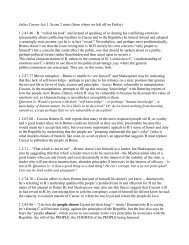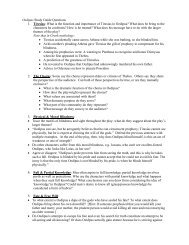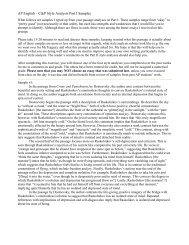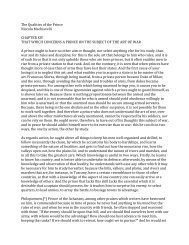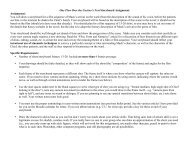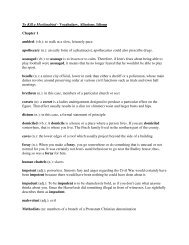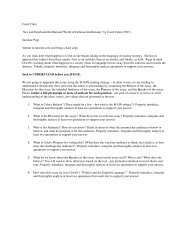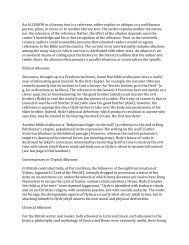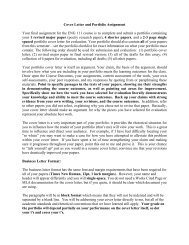Outline of Aristotle's Theory of Tragedy in the ... - Whs.babienko.net
Outline of Aristotle's Theory of Tragedy in the ... - Whs.babienko.net
Outline of Aristotle's Theory of Tragedy in the ... - Whs.babienko.net
- No tags were found...
Create successful ePaper yourself
Turn your PDF publications into a flip-book with our unique Google optimized e-Paper software.
<strong>Outl<strong>in</strong>e</strong> <strong>of</strong> <strong>Aristotle's</strong> <strong>Theory</strong> <strong>of</strong> <strong>Tragedy</strong>http://www2.cnr.edu/home/bmcmanus/poetics.htmlgood or bad fortune.” He argues that <strong>the</strong> best plots comb<strong>in</strong>e <strong>the</strong>se two as part <strong>of</strong> <strong>the</strong>ir causeand-effectcha<strong>in</strong> (i.e., <strong>the</strong> peripeteia leads directly to <strong>the</strong> anagnorisis); this <strong>in</strong> turns creates <strong>the</strong>catastrophe, lead<strong>in</strong>g to <strong>the</strong> f<strong>in</strong>al “scene <strong>of</strong> suffer<strong>in</strong>g” (context). Application to Oedipus <strong>the</strong>K<strong>in</strong>g.Character has <strong>the</strong> second place <strong>in</strong> importance. In a perfect tragedy, character will support plot, i.e.,personal motivations will be <strong>in</strong>tricately connected parts <strong>of</strong> <strong>the</strong> cause-and-effect cha<strong>in</strong> <strong>of</strong> actionsproduc<strong>in</strong>g pity and fear <strong>in</strong> <strong>the</strong> audience. The protagonist should be renowned and prosperous, so hischange <strong>of</strong> fortune can be from good to bad. This change “should come about as <strong>the</strong> result, not <strong>of</strong> vice,but <strong>of</strong> some great error or frailty <strong>in</strong> a character.” Such a plot is most likely to generate pity and fear <strong>in</strong><strong>the</strong> audience, for “pity is aroused by unmerited misfortune, fear by <strong>the</strong> misfortune <strong>of</strong> a man likeourselves.” The term Aristotle uses here, hamartia, <strong>of</strong>ten translated “tragic flaw,” has been <strong>the</strong> subject<strong>of</strong> much debate. The mean<strong>in</strong>g <strong>of</strong> <strong>the</strong> Greek word is closer to “mistake” than to “flaw,” and I believe itis best <strong>in</strong>terpreted <strong>in</strong> <strong>the</strong> context <strong>of</strong> what Aristotle has to say about plot and “<strong>the</strong> law or probability ornecessity.” In <strong>the</strong> ideal tragedy, claims Aristotle, <strong>the</strong> protagonist will mistakenly br<strong>in</strong>g about his owndownfall—not because he is s<strong>in</strong>ful or morally weak, but because he does not know enough. The role<strong>of</strong> <strong>the</strong> hamartia <strong>in</strong> tragedy comes not from its moral status but from <strong>the</strong> <strong>in</strong>evitability <strong>of</strong> itsconsequences. Hence <strong>the</strong> peripeteia is really one or more self-destructive actions taken <strong>in</strong> bl<strong>in</strong>dness,lead<strong>in</strong>g to results diametrically opposed to those that were <strong>in</strong>tended (<strong>of</strong>ten termed tragic irony), and<strong>the</strong> anagnorisis is <strong>the</strong> ga<strong>in</strong><strong>in</strong>g <strong>of</strong> <strong>the</strong> essential knowledge that was previously lack<strong>in</strong>g (context).Application to Oedipus <strong>the</strong> K<strong>in</strong>g.Characters <strong>in</strong> tragedy should have <strong>the</strong> follow<strong>in</strong>g qualities (context):1.2.3.4.5.6.“good or f<strong>in</strong>e.” Aristotle relates this quality to moral purpose and says it is relative to class:“Even a woman may be good, and also a slave, though <strong>the</strong> woman may be said to be an <strong>in</strong>feriorbe<strong>in</strong>g, and <strong>the</strong> slave quite worthless.”“fitness <strong>of</strong> character” (true to type); e.g. valor is appropriate for a warrior but not for a woman.“true to life” (realistic)“consistency” (true to <strong>the</strong>mselves). Once a character's personality and motivations areestablished, <strong>the</strong>se should cont<strong>in</strong>ue throughout <strong>the</strong> play.“necessary or probable.” Characters must be logically constructed accord<strong>in</strong>g to “<strong>the</strong> law <strong>of</strong>probability or necessity” that governs <strong>the</strong> actions <strong>of</strong> <strong>the</strong> play.“true to life and yet more beautiful” (idealized, ennobled).Thought is third <strong>in</strong> importance, and is found “where someth<strong>in</strong>g is proved to be or not to be, or ageneral maxim is enunciated.” Aristotle says little about thought, and most <strong>of</strong> what he has to say isassociated with how speeches should reveal character (context 1; context 2). However, we mayassume that this category would also <strong>in</strong>clude what we call <strong>the</strong> <strong>the</strong>mes <strong>of</strong> a play.Diction is fourth, and is “<strong>the</strong> expression <strong>of</strong> <strong>the</strong> mean<strong>in</strong>g <strong>in</strong> words” which are proper and3 <strong>of</strong> 4 4/15/10 3:58 PM
<strong>Outl<strong>in</strong>e</strong> <strong>of</strong> <strong>Aristotle's</strong> <strong>Theory</strong> <strong>of</strong> <strong>Tragedy</strong>http://www2.cnr.edu/home/bmcmanus/poetics.htmlappropriate to <strong>the</strong> plot, characters, and end <strong>of</strong> <strong>the</strong> tragedy. In this category, Aristotle discusses <strong>the</strong>stylistic elements <strong>of</strong> tragedy; he is particularly <strong>in</strong>terested <strong>in</strong> metaphors: “But <strong>the</strong> greatest th<strong>in</strong>g by faris to have a command <strong>of</strong> metaphor; . . . it is <strong>the</strong> mark <strong>of</strong> genius, for to make good metaphors impliesan eye for resemblances” (context). Application to Oedipus <strong>the</strong> K<strong>in</strong>g.Song, or melody, is fifth, and is <strong>the</strong> musical element <strong>of</strong> <strong>the</strong> chorus. Aristotle argues that <strong>the</strong> Chorusshould be fully <strong>in</strong>tegrated <strong>in</strong>to <strong>the</strong> play like an actor; choral odes should not be “mere <strong>in</strong>terludes,” butshould contribute to <strong>the</strong> unity <strong>of</strong> <strong>the</strong> plot (context).Spectacle is last, for it is least connected with literature; “<strong>the</strong> production <strong>of</strong> spectacular effectsdepends more on <strong>the</strong> art <strong>of</strong> <strong>the</strong> stage mach<strong>in</strong>ist than on that <strong>of</strong> <strong>the</strong> poet.” Although Aristotlerecognizes <strong>the</strong> emotional attraction <strong>of</strong> spectacle, he argues that superior poets rely on <strong>the</strong> <strong>in</strong>nerstructure <strong>of</strong> <strong>the</strong> play ra<strong>the</strong>r than spectacle to arouse pity and fear; those who rely heavily on spectacle“create a sense, not <strong>of</strong> <strong>the</strong> terrible, but only <strong>of</strong> <strong>the</strong> monstrous” (context 1; context 2).The end <strong>of</strong> <strong>the</strong> tragedy is a katharsis (purgation, cleans<strong>in</strong>g) <strong>of</strong> <strong>the</strong> tragic emotions <strong>of</strong> pity andfear. Katharsis is ano<strong>the</strong>r Aristotelian term that has generated considerable debate. The word means“purg<strong>in</strong>g,” and Aristotle seems to be employ<strong>in</strong>g a medical metaphor—tragedy arouses <strong>the</strong> emotions <strong>of</strong>pity and fear <strong>in</strong> order to purge away <strong>the</strong>ir excess, to reduce <strong>the</strong>se passions to a healthy, balancedproportion. Aristotle also talks <strong>of</strong> <strong>the</strong> “pleasure” that is proper to tragedy, apparently mean<strong>in</strong>g <strong>the</strong>aes<strong>the</strong>tic pleasure one gets from contemplat<strong>in</strong>g <strong>the</strong> pity and fear that are aroused through an<strong>in</strong>tricately constructed work <strong>of</strong> art (context).We might pr<strong>of</strong>itably compare this view <strong>of</strong> Aristotle with that expressed by Susanne Langer <strong>in</strong> our firstread<strong>in</strong>g (“Expressiveness <strong>in</strong> Art,” excerpt from Problems <strong>of</strong> Art: Ten Philosophical Lectures, NewYork, Scribner, 1957):A work <strong>of</strong> art presents feel<strong>in</strong>g (<strong>in</strong> <strong>the</strong> broad sense I mentioned before, as everyth<strong>in</strong>g thatcan be felt) for our contemplation, mak<strong>in</strong>g it visible or audible or <strong>in</strong> some wayperceivable through a symbol, not <strong>in</strong>ferable from a symptom. Artistic form is congruentwith <strong>the</strong> dynamic forms <strong>of</strong> our direct sensuous, mental, and emotional life; works <strong>of</strong> art . .. are images <strong>of</strong> feel<strong>in</strong>g, that formulate it for our cognition. What is artistically good iswhatever articulates and presents feel<strong>in</strong>g for our understand<strong>in</strong>g. (661-62)November, 1999Barbara F. McManusCLS 267 Topics Page4 <strong>of</strong> 4 4/15/10 3:58 PM


